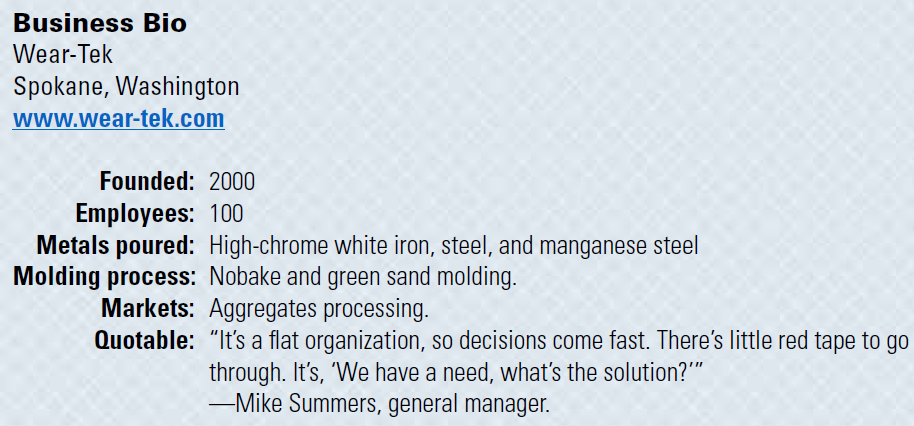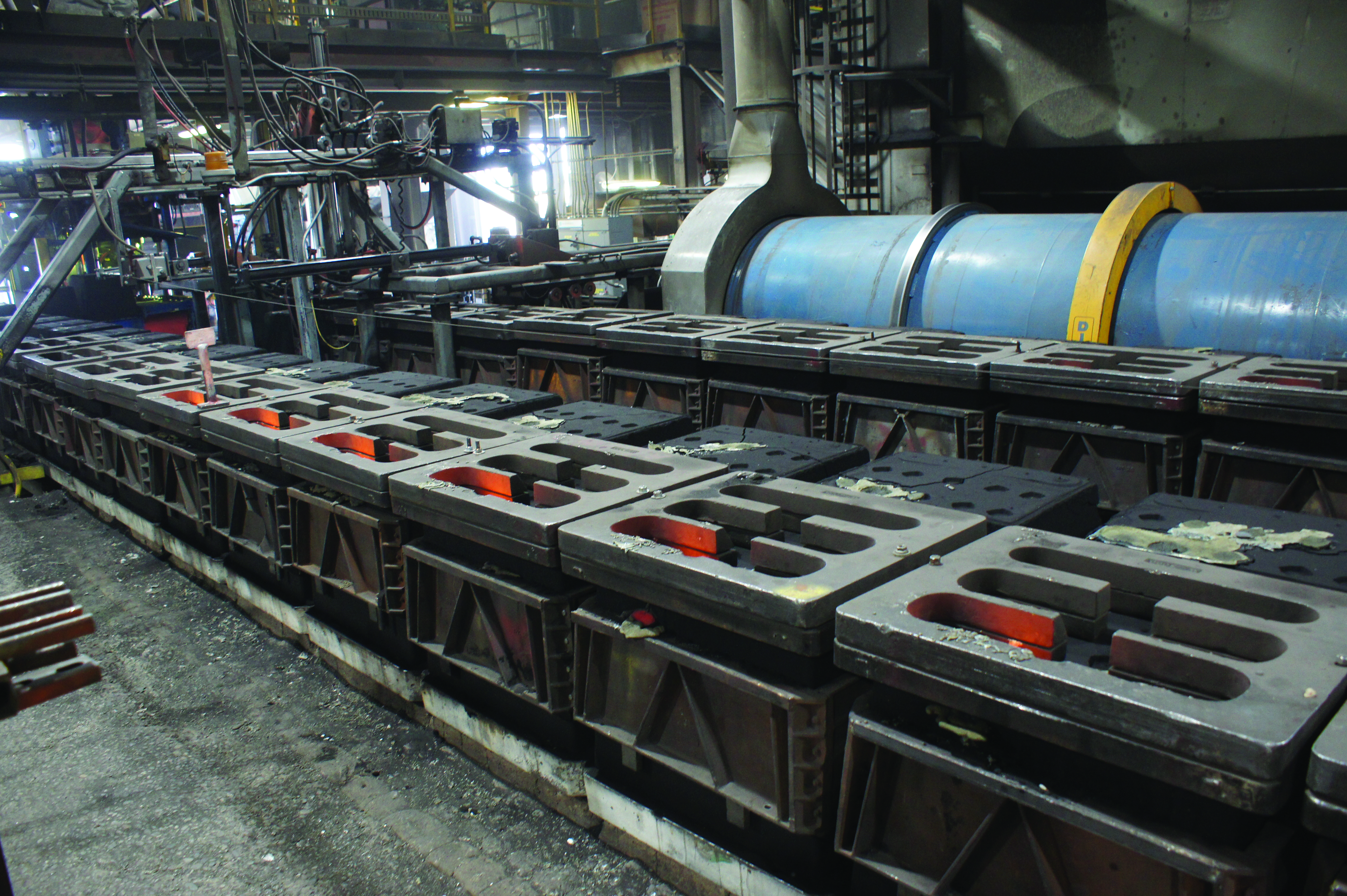Wear-Tek’s Engineered Results
The maker of wear-resistant castings switched its molding sand material to ensure compliance with the OSHA silica PEL.
AFS Corporate Member Wear-Tek (Spokane, Washington) is a job shop making high-chrome white iron, steel, and manganese castings primarily for the aggregates industry. While its niche is strongly tied to a single OEM market, the relationships with those customers have given Wear-Tek a strong foothold to withstand the ebbs and flows of that industry.
“Our customers know they can trust us, and we have been doing this for a long time, so we know the cycle and what to expect,” said Mike Summers, general manager, Wear-Tek.
Summers came to the foundry from a customer in the rock-crushing business in 2012, bringing with him knowledge of the market and established relationships with the customer OEMs.

Wear-Tek makes castings via no-bake and green sand molding lines, operating six furnaces with four power supplies melting at 3,000 lbs. per hour. Sales have grown annually since 2000, and the company continually reinvests in itself to stay competitive and efficient.
Wear-Tek’s sales help fund its improvements. But it’s the staff at Wear-Tek that performs the legwork to make the improvements successful.
Switching From Silica to Ceramic
Earlier this year, Wear-Tek made the decision to convert from silica sand to ceramic media from AFS Corporate Member Carbo Ceramics in order to avoid the risk of noncompliance with the silica sand PEL.
As a foundry operating nobake and green sand molding lines, Wear-Tek had the challenge of planning the transition for both systems. On the nobake side, the replacement was fairly straightforward.
“At the beginning of the project, we shut the whole nobake line down for a week,” he said. “We completely drained the system of all the silica sand, and then went into the building and cleaned out the silica from top to bottom.”
Once the silica was removed, the new ceramic media was loaded into the system through its normal sand addition process.
“We filled the system back up at the rate everything moves in the molding and casting process,” Summers said. “We don’t have direct access to the silo, so it took a couple of days for that to fill back up.”
To prepare for the new molding material, Wear-Tek performed considerable small-batch testing beforehand. On weekends, between shifts, and during lunch breaks, the foundry would empty a small silo right before the mixer and run different recipe scenarios with the binder it had been using with the silica sand.
“We did a lot of research before and tried to get everyone’s opinion,” Summers said. “We made step mold patterns and poured castings out of that—not just with the Carbo product but many other sands out there to try to determine which media to use.”
Once it was time to make the full-scale switch, some fine-tuning was required to achieve the optimal molding parameters. Summers admits the results of the small-scale tests did not completely match up with what eventually worked best on the larger scale.
“We probably started a little too light on binder percentage, because we knew that is part of where the cost savings is,” he said. “But the molds were not setting hard enough at first. So, we slowly bumped up our binder, but it is still lower than what we were using for silica.”
This fall, Wear-Tek also installed mechanical reclamation for the nobake line to reclaim as much of the more expensive ceramic sand as possible. With the fine-tuning, the nobake transition went fairly smoothly. Making the change in the green sand line at Wear-Tek was more challenging.
To completely drain the sand system in the green sand line would have shut down Wear-Tek’s production for at least three weeks. Instead, the company opted for a more gradual transition. Early in 2019, it drained its green sand system to approximately 60% silica sand and then filled the rest with the ceramic sand. The ceramic sand is harder than silica, so over time, the silica sand broke down and was drawn off to the baghouse. As of October, Summers estimated the system to be down to 10% or less of silica sand.

“That part worked pretty well,” Summers said. “And at first, the molds looked pretty good.”
But as the sand system’s balance shifted toward ceramic, Wear-Tek noticed the surface finish of the castings was getting rougher.
“On the nobake side, your results happen fairly quickly,” Summers said. “You change the binder level in the mixer, and you can see right away how it affects the mold.”
Adjustments in nobake could be made quickly and the impact of the change could be determined easily. Changes in the green sand system took longer to come into effect, and it was harder to pinpoint whether adjustments improved or worsened the end result.
Through steady testing and conversations with the sand and clay suppliers, Wear-Tek eventually concluded what was causing the rough surface—an addition in the clay wasn’t reacting well with the sand and molten metal—causing the sand to become coarser over time.
“Unfortunately, we don’t have any way to extract the clay out, so we are waiting for the old clay to breakdown and filter out,” Summers said. “It can take 2-3 months.”
When unforeseen challenges crop up, Wear-Tek’s team rallies to find a solution. In the case of the green sand mystery, metallurgist Jerrod Miller who was in charge of the metal and sand systems, led the drive in talking with suppliers and leading the testing. In this case, they developed a new test casting shape with a lot of surface area to examine the metal/sand interface reaction occurring.
Engineering a Remelt Solution
Another example of Wear-Tek’s problem-solving attitude is the way it organizes the remelt stock. As a job shop pouring a large range of alloys, keeping track of its remelt inventory was cumbersome.
“It’s easy to make a virgin mix for an alloy, but using remelt requires more attention,” Summers said. “We are carrying this inventory and it takes up space. It was marked, but not organized very well. We would come out (to where the remelt is stored) and see something that had been sitting for three months and think, ‘Wow, that should have been out of here by now.’”
Summers said it is common for the team at Wear-Tek to have regular conversations about what can or should be improved at the foundry.
“We have several engineers here—metallurgical and mechanical—so we will talk about what we struggle with and come up with ideas,” he said. “Here’s our challenge, we have to do this every day, what would make this function better?”
Simplifying the remelt inventory came up in several of these conversations, and a solution was engineered earlier this year. Wear-Tek created with a system in which every bin containing remelt was made to a specific size so they could be stacked better. One end of the bin had a solid backing, while the other end is open, allowing the pieces of metal to slide into the furnace when the bin is tilted. The sliders are all uniform in size. Every bin of remelt is weighed and that weight is marked on the bin.
“It speeds up the process of reusing our remelt stock,” Summers said. “We can get it back into molten metal and into castings rather than sitting in inventory.”
This type of engineered solution is not uncommon at Wear-Tek. Summers points to the way the management hierarchy is set up.
“It’s a flat organization, so decisions come fast,” he said. “There’s little red tape to go through. It’s, ‘We have a need, what’s the solution?’”
Upgrading Its ERP
Many times, a solution to a problem is found through a foundry’s suppliers. Wear-Tek worked closely with its suppliers during its transition to ceramic sand. It also turned to an outside vendor when it was challenged with keeping its enterprise resource planning (ERP) system up to date.
Wear-Tek was using a legacy ERP system created in-house several years ago by a former employee. The program was based on obsolete software systems and multiple patches that were becoming unwieldy.
“What we had served us well over the years,” Summers said. “We were doing everything by computer, not paper, and when production needed to know something they would go to the terminals for that information. But we were in a struggle about how to keep it going.”
Wear-Tek had separate software for the financial side of its business, as well as a separate software program for its clocking system.
“We wanted a new system that allowed us to do more and consolidate what we were already doing,” Summers said. “We felt going to a commercial software was the best way to do it.”
Wear-Tek selected AFS Corporate Member B&L Information Systems’ Odyssey and launched its new system in October after months of planning. The software links Wear-Tek’s accounting, production and timekeeping and allows the foundry to track its processes along the way. When someone calls about the status of their order, Wear-Tek can see where the casting is in real-time.
“It will help us better schedule things. We have 30 different alloys, which can be a challenge to schedule,” Summers said. “Hopefully this will give us better information on how to do that better.”
The system could also boost interactions with the customer by making answers more readily available. Building upon that trust is the ultimate goal for Wear-Tek.
“Our niche is that OEM relationship,” Summers said.
Click here to see this story as it appears in the January 2020 issue of Modern Casting.